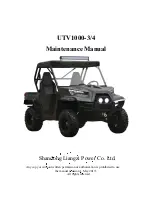
21
Safe Riding Practices
Chapter 11
You should know safe riding practices and be aware of the environ-
mental concerns shared by responsible riders. Being prepared and know-
ing how to survive is your best safeguard in case of an emergency like a
breakdown or sudden storm.
Plan Ahead
Good planning, following the recommended maintenance schedule of
your ATV, travelling in the company of others, and practicing safe riding
habits should eliminate most emergencies.
If you decide to ride in areas where a breakdown could threaten your
survival, you should prepare yourself by learning survival techniques. In
many states survival information is available through state departments
or agencies involved in outdoor recreation. Use these and other sources
to gather survival information appropriate to the area you plan to ride.
Before you leave:
•
Prepare and secure emergency supplies, tools, first aid kit, and any
other items necessary for your ride.
•
Let someone know your route and when you should return.
•
Take a two way radio and emergency beacon.
If you are stranded and you determine help is too far away to walk:
•
Use good judgement and common sense. When facing an emergency,
remain calm - panic is your worst enemy.
•
If you need a fire, select a protected area away from the ATVs and any
overhanging branches containing dry leaves. Start your fire using
small dry sticks and branches, gradually adding larger pieces of wood
as required.
•
Before leaving your emergency shelter, make sure all ashes are
smothered. One hot ash from your fire could destroy an entire riding
area. If you have to spend the night, collect enough wood before it
gets dark.
•
Whenever you are both stranded and injured, attend to injuries first,
then sit down and think out solutions and possibilities.
•
Do not travel on foot in strange areas after dark. Conserve all the ener-
gy you can because it will help keep you warm.
Survival Kit
A survival kit is an absolute necessity when planning a long ride on
your ATV. Whether with a group or just a friend, a survival kit should be
included with your supplies on each ride. Prepare your kit according to
the local conditions. It should easily fit into a can or other small, water-
proof container, to store under the seat, in a bum bag or backpack. Just
like the emergency food supply and tool kit, this survival kit applies to all
terrains, from the woods to the desert.
Whenever you plan an extended ride or you are going farther than you
can walk back in a reasonably short period of time, you should carry at
least the following in your bum bag/backpack:
•
Trail food
•
Water purification tablets
•
An area map
•
A good, shock-resistant compass
•
Lighter or waterproof matches
•
Small signal mirror
•
Emergency space blanket
•
Compact first aid kit
•
15 metres of sturdy rope
•
2 metres of rolled duct tape
•
Small flashlight
•
Pencil/pen and paper
•
Hand axe/brush cutter
•
Signal flares
•
Two way radio or Satellite phone
•
Emergency Beacon
•
And always, without exception, CARRY WATER.
Local camping, backpacking or military surplus stores are good
sources for quality, lightweight products that are well suited to the rigors
of trail riding.
First Aid
ATV accidents can cause bodily injury as well as equipment damage.
The most hazardous situation occurs when a person is injured and alone,
kilometres from help. Any injury can be serious if handled carelessly. You
may have to care for your own injuries and someone else’s trauma when
you least expect it.
A first-aid kit is easy to make and should contain at least the following.
Six bandaids, two 50mm crepe bandages, four 100mm crepe ban-
dages, four triangular bandages, one roll of 50mm gauze, one roll of
25mm gauze, and one roll of 25mm adhesive tape.
Select a small waterproof container to store the above items on your
ATV or in your backpack.
Never remove a helmet from an injured rider unless
necessary. Severe injury could result if done improperly.
In case of an emergency, be calm, firm and reassuring to the injured
person. Do as much as you can for them and, if possible, send others for
help.
For your own benefit and that of your friends, you should learn basic
first aid.
Ground to Air Rescue Signals
If you find yourself in a position where you have to communicate with
a plane, use these signals. The markings should be at least 6 metres long
and 1 metre wide so they can be easily read from the air. The markings
can be stamped in the snow, or logs, rocks or branches positioned to
form signals.
v
Below: Universal ground to air distress signal





































